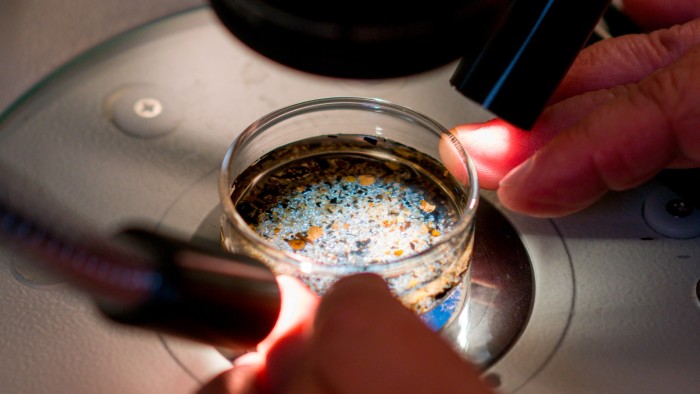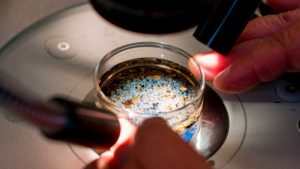How harmful are microplastics to human health?

Plastic is everywhere, including, it seems, in our own bodies. Should we be worried?
In March, a group of Italian scientists published a study on people undergoing surgery for clogged arteries. More than half of the 257 patients examined had microplastics — tiny particles of plastic — in the plaque in their arteries.
When the researchers followed up nearly three years later, they found that the patients with the microplastics were significantly more likely to have suffered a stroke, a heart attack, or death from any cause.
Their study is one of the most ambitious attempts yet to link microplastics to serious effects on human health. But critics have questioned its validity, arguing that the scientists’ samples may have been contaminated and their techniques unable to detect plastic precisely.
The episode highlights how limited our knowledge is about microplastics. “I feel sometimes, from a scientific perspective, we are coming short in giving the answer that people want,” says Roel Vermeulen, a professor at the University of Utrecht. “But good research does take time.”
He co-ordinates an EU research programme on microplastics and nanoplastics — fragments that are respectively less than 5mm and less than one-thousandth of a millimetre in size.

Such particles have become ubiquitous, mainly caused by the degradation of larger products that we depend on — from food packaging to clothes. They have been found in human organs, including the lung and the heart. A recent study found polypropylene and other plastics in the olfactory bulb of the brain; breathing was the most likely route for the plastics to have arrived there, concluded the authors, based in Germany and Brazil.
The field studying their health impact, however, is less than a decade old. Although most researchers accept that microplastics are likely to affect our health, there is a lack of high-quality studies and of agreed research methods. So politicians, regulators, companies, and the public are taking decisions about plastics use on a relatively narrow scientific basis.
Vermeulen emphasises two key points: first, that the increasing production of plastics is environmentally unsustainable; and, second, that other forms of particle pollution — including air pollution, and plastic-associated chemicals, like so-called forever chemicals — have been linked to health impacts.
“If we think about air pollution, we know that small particles can get through the barriers of the lung, can get into the bloodstream and end up in any organ in the body,” he says. “We know that this can lead to many different diseases, varying from cardiovascular disease to cancers.”
It would be logical if plastic particles, too, had health effects. Indeed, a minority of air pollution particles are plastics, from tyre wear.
However, Stephanie Wright, an environmental toxicology lecturer at Imperial College London, urges caution over some of the studies that have found microplastics in the body. She suggests that the plastic detected could have been inadvertently introduced during the scientific process. “Our gut, our lungs — they’ve evolved to keep things out,” says Wright.
And, while the rise of plastic products in recent decades has coincided with the rise of certain diseases, including inflammatory bowel disease, there are other possible explanations for the latter, such as the shift to ultra-processed food.
To go beyond speculation, scientists must identify direct biological links. In laboratory studies, the presence of microplastics has caused inflammation in human cells, and in rats and mice. Yet we do not know how much microplastic humans are exposed to and, therefore, whether the quantities used in laboratory experiments reflect human experience.
“If you don’t know exposure levels in the general population, it’s very hard to understand what those laboratory studies mean in terms of health,” says Wright. “I do believe we’re exposed to microplastic, I do believe there could be harm, but I’m not sure that I’ve seen the evidence yet.”
Another difficulty is that lab studies tend to use pristine versions of the most common plastics, such as polyethylene. “That’s not what you find in the environment, because they have degraded and absorbed other chemicals,” says Vermeulen.
Today’s products use thousands of permutations of plastics and chemical additives. “To test all of those will be very, very difficult, if not impossible,” Vermeulen adds.
His team is examining the placentas of hundreds of pregnant women for micro- and nano-plastics, then looking for correlations with birth outcomes and child development. The study is not expected to be completed before 2026.
Previous research has shown how many workers in fabric factories, who inhaled nylon and other small fibres, suffered from lung disease. Wright’s team is looking at whether microplastic exposure leads to similar scarring in the lungs.

Some consumers are inclined to take action now. Knowing, for example, that micro- and nano-plastics are released — especially when plastics are heated — they avoid microwaving plastic containers, and shun plastic tea-bags, cups or kettles.
Yet individual action alone can have only a limited impact: as long as more plastics are released into the environment, we will continue to breathe them in, and ingest them with our food. And the ubiquity of plastics across modern economies means that curbing their use will not be straightforward.
While scientists untangle plastic’s impact on humans, many want regulators to step in — to take a precautionary approach. The EU has already banned companies from adding microplastics to products such as cosmetics, but that leaves the bigger problem of the microplastics that come from the breakdown of larger plastics.
Global plastic production is expected to double by 2050, creating significant greenhouse gas emissions and, ultimately, waste that will harm ecosystems and wildlife. “There’s all kinds of reasons to say: let’s act now,” argues Vermeulen.
#harmful #microplastics #human #health







